Bulgarian "almost Apple" 1988
This article is about a clone of the American computer Apple, which was available in the Soviet Union and was produced in Bulgaria.
On the line of these computers was brought up the current generation of it-Schnick.
Meet the new exhibit of our computer history museum, Pravez 8D.

Today I want to tell you about the next very interesting exhibit of our museum of computer antiquities . It's about the Pravets 8D computer.
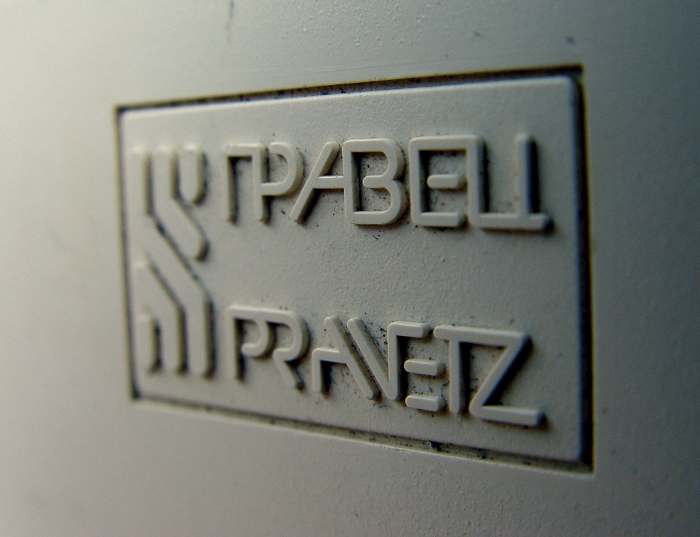
The line of these computers can be called legendary only for the fact that at one time he stood in every third school (Pravtsy 8A were supplied to educational institutions) of the entire Soviet Union, as well as the majority of the socialist countries of the world. Many of today's IT specialists began precisely with Pravtsev, it was he who became for many their "first computer in life."
')
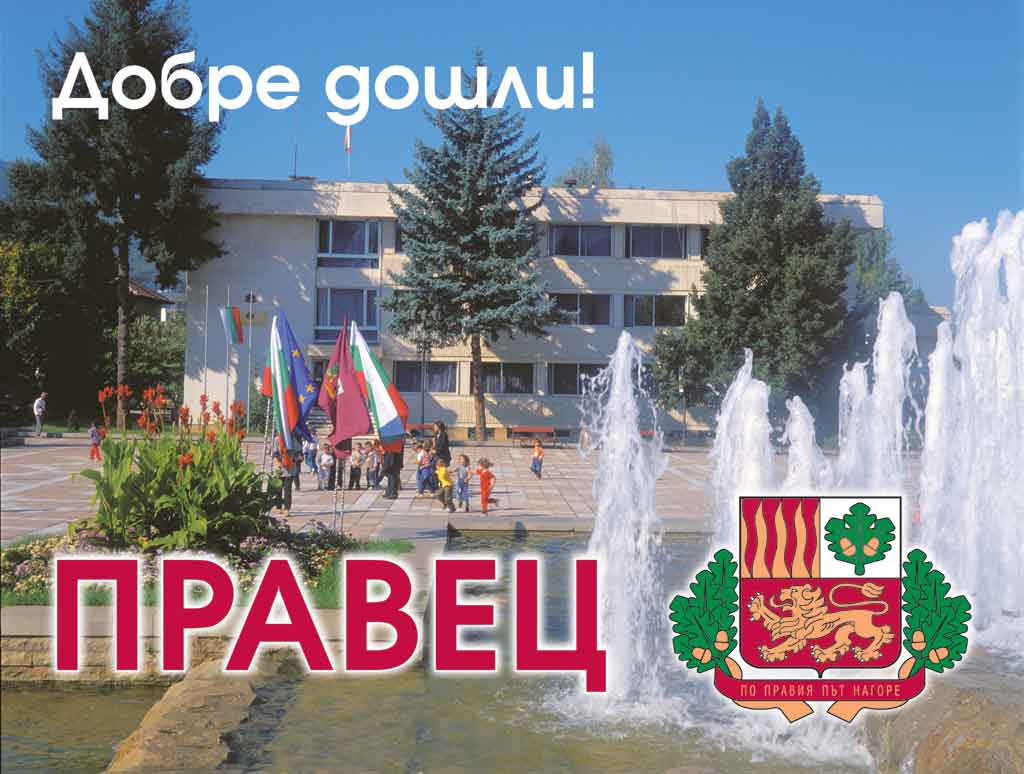
The name "Pravets" comes from the name of a small village in Bulgaria, in which there is a plant called "MIROPROCESSORN SYSTEMS", which actually produced these computers. Computers were produced for the fact that in the socialist countries there would be at least something that could be opposed to the American Eplum, which in those years had already gained some popularity.
The first computer that went into the series was IMKO-1 (Individual MikroKompyutr, sometimes deciphered as: Ivan Marangozov Copier Original, in honor of the creator) and it was released in 1980. They tried to make it as similar in functionality as possible with the Apple II. Almost it turned out - the computer received a RAM (RAM) of 48 KB (with the possibility of expansion to 64 KB), a ROM (ROM) of 12 KB. Central processor 1 MHz (exactly the same as the Apple II). A streamer was used as a storage device, since no disk drives were made in Bulgaria yet.
Interestingly, this model was primarily price - $ 2600, while Japanese and American counterparts were much more expensive.
They produced IMKO-1 until 1982, until it was replaced by IMKO-2 or, as it was also called, Pravets-82. By the way, the success of IMKO-1 pushed the Bulgarians to expand the department for the production of radioelectronic components in the city of Pravets to a factory for the production of personal computers. After Pravts-82 was the Pravets 8M (IMKO-2M), which was already based on the 2 most popular at the time time processors Z80 and MOS 6502.
Computers series "Pravets 8" were fully compatible with Apple II, both software and hardware. On Pravtsy it was possible to use the programs of the original Apple II, as well as its expansion card, without any modifications. The ROM of the character generator and Monitor control programs was slightly modified to support Cyrillic (uppercase Cyrillic letters instead of lowercase Latin letters), as well as to display the name PRAVETS (IMKO, IMCO-2M) instead of APPLE II when turned on. In addition, the Pravets 8 produced its own expansion cards - to increase the RAM to 192 or 256 KB, as well as the U-LAN board, which allows you to connect computers to a local network. The operating systems used are Apple DOS , ProDOS , UCSD P-System , CP / M (with a CP / M card), the most commonly used programming languages are assembly language , Applesoft BASIC , UCSD Pascal , Logo .
In 1985, the plant management (not without instructions from Todor Zhivkov, the first secretary of the Communist Party of Bulgaria, who, by the way, is from the city of Pravets), decided to create a “home computer” Pravets 8D:
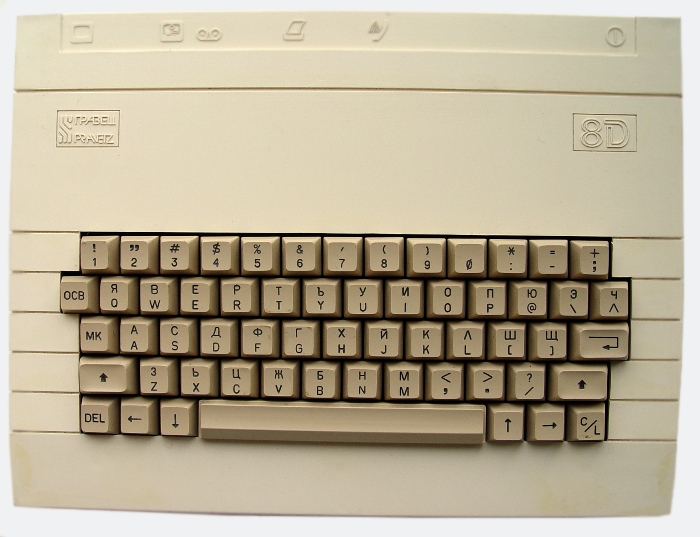
For this model, a smaller case with a built-in keyboard unit was specially manufactured. The monitor was not shipped with it - instead it was supposed to use an ordinary household TV. The ROM was also changed to support both Latin and Cyrillic.
Initially, a cassette recorder was used as an external memory (which was supposed to be for those who would have a television), later, in 1990, a disk drive controller and a DOS-8D disk operating system appeared. The approximate price was around $ 290.

The Pravets 8D looked like, at the time of production, it is quite “fashionable” if you compare it with similar computers of that time, such as Vesta IK-31 or Sail VI-201 .

Take at least the case - white matte plastic, with branded peripheral badges (they, by the way, are very, very similar to icons on Apple computers ):

The power supply is built in, everything is very neat and clear.
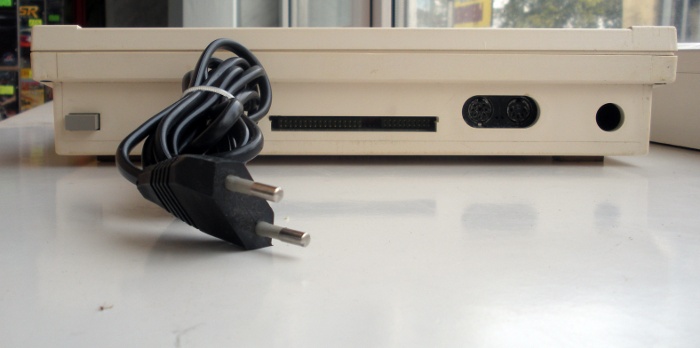
In general, the Bulgarians managed to achieve a very large “similarity” to the original - Apple II, with both the hull and the parameters:
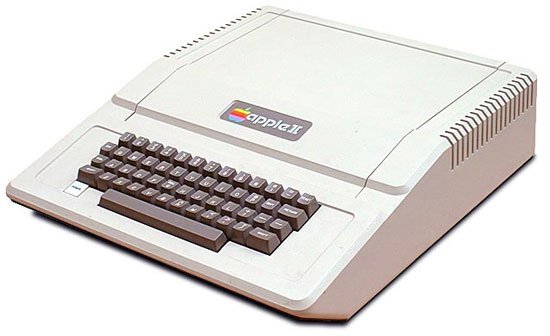
Well, software, as I said, you could use the same thing:
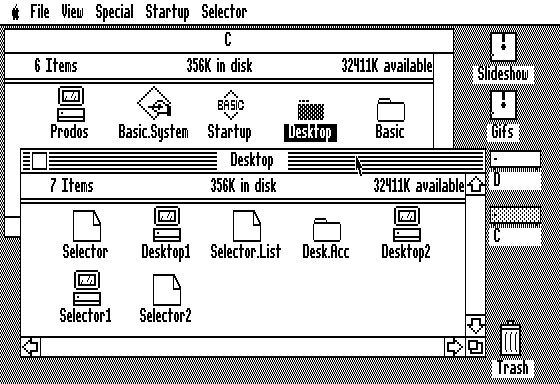
Well, my favorite toy on the Pravce school was “Moon Patrol” (moon patrol), in which you had to jump over the pits and shoot from all that above and to the right:
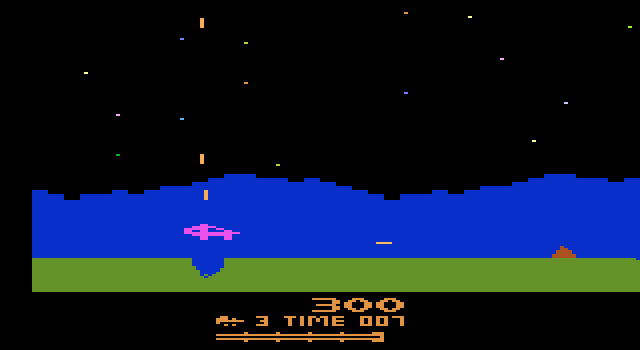
... only the monitors we had were not color, but black and green.
The keyboard at Pravets is a little different from the modern ones. First of all, the layout - no you "fyfva." Cyrillic is relatively Latin based on the principle of correspondence of transcription:

This layout is often called “YAVERT”, and its correct name is “phonetic”.
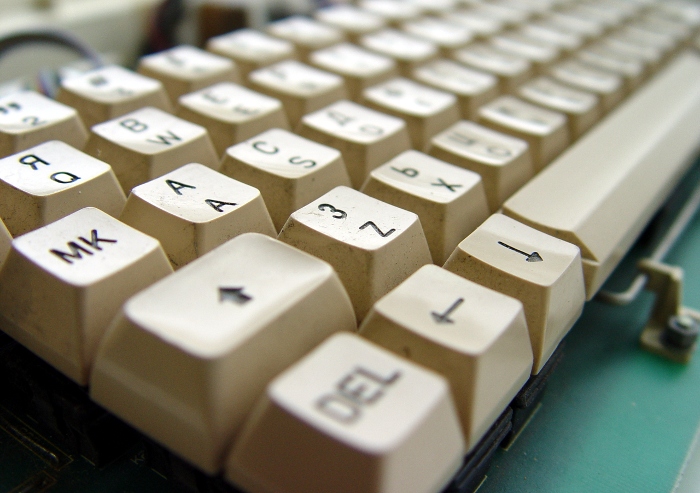
This “chord” was not so convenient for typing on one keyboard of the world :)
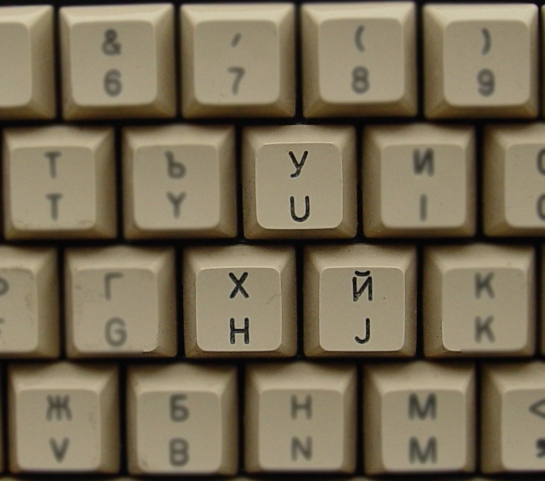
Each key on these keyboards was a separate element sealed into the board, in contrast to modern keyboards, where there is a common plate under the keys:
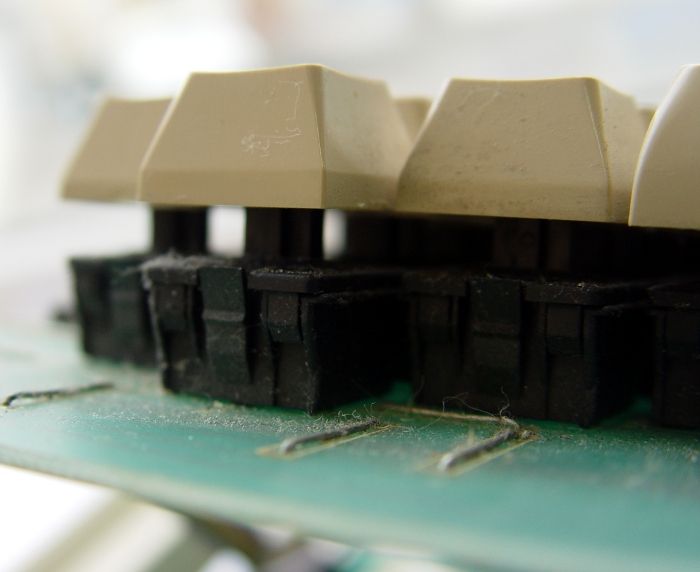
The "space" a separate mount
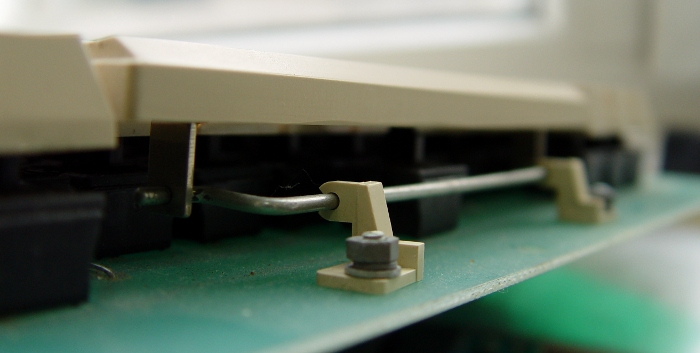
The staple is needed in order to press it from any direction, and not only in the center:
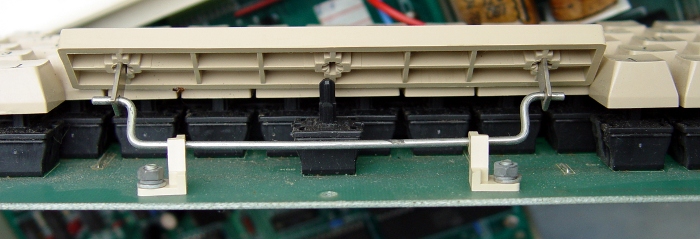
The buttons are "worn" on the key. All keys, except for the space, are glued, apparently, that they would not fly off.
The Pravets 8D computer itself consists of 3 parts - a printed circuit board with a keyboard, a power supply unit and a motherboard (if we draw analogies with modern computers).
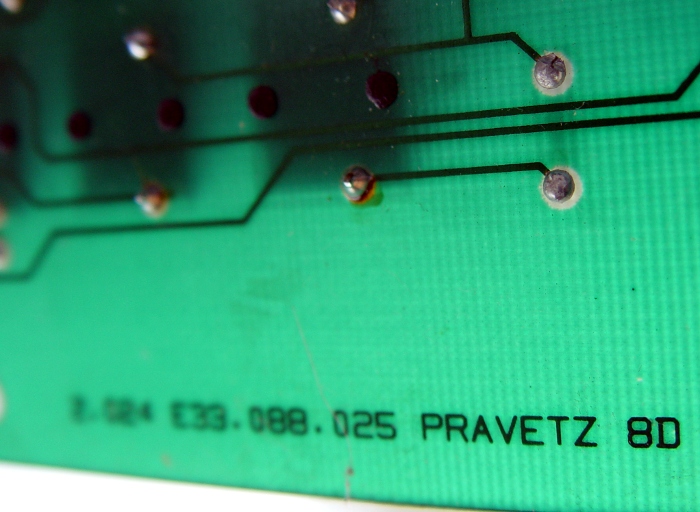
On the keyboard board, the name “PRAVETZ 8D” is proudly etched.
But what this analog Apple looks like inside:
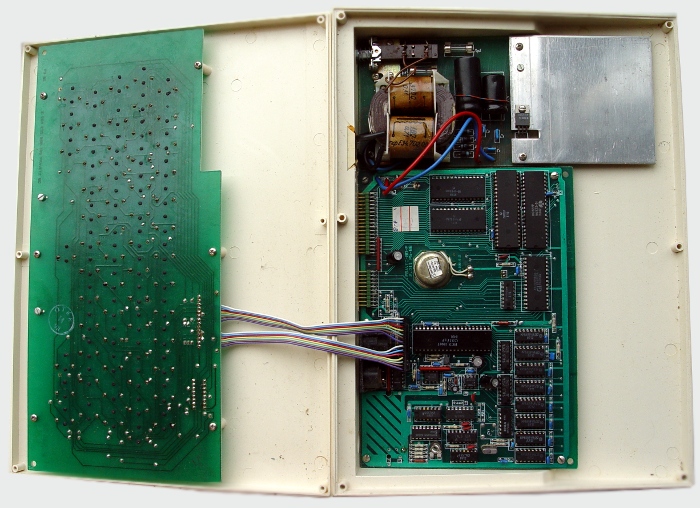
On the left is the keyboard, on the upper right of the power supply, and the rest is the computer itself.
The keyboard was replaceable and joined here with this “almost train”:
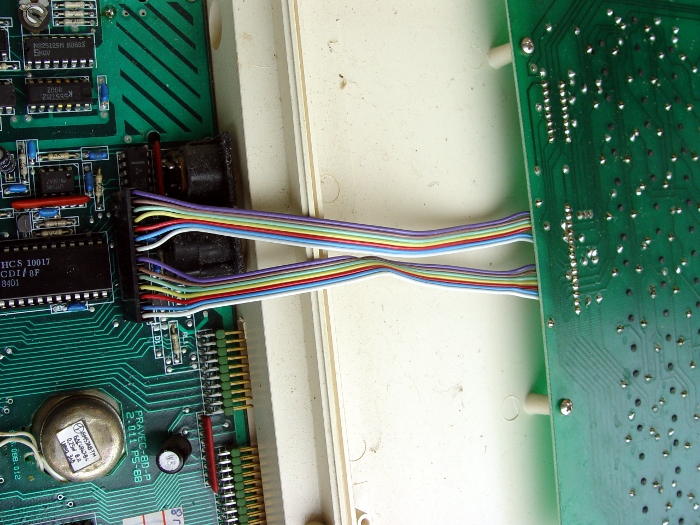
The CM630P CPU, which is actually a complete clone of the MOS Technology 6502 processor, which was used in computers like Apple I, Apple II and Commodore PET, on the left, the AY-3-8912 programmable sound generator that could generate 3- voice polyphony (8 octaves + white noise):
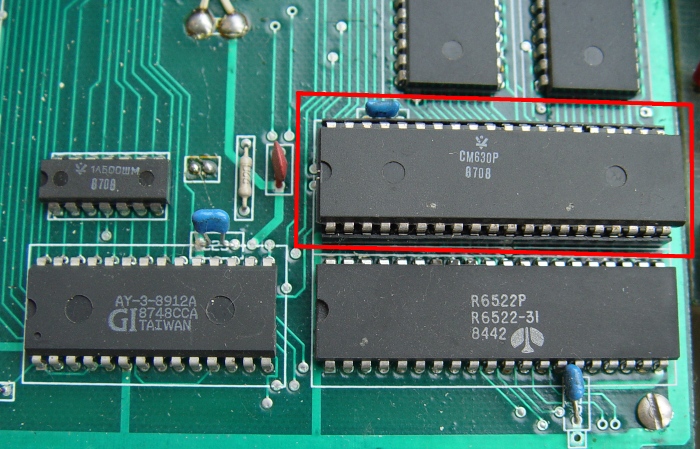
This is what RAM looks like:
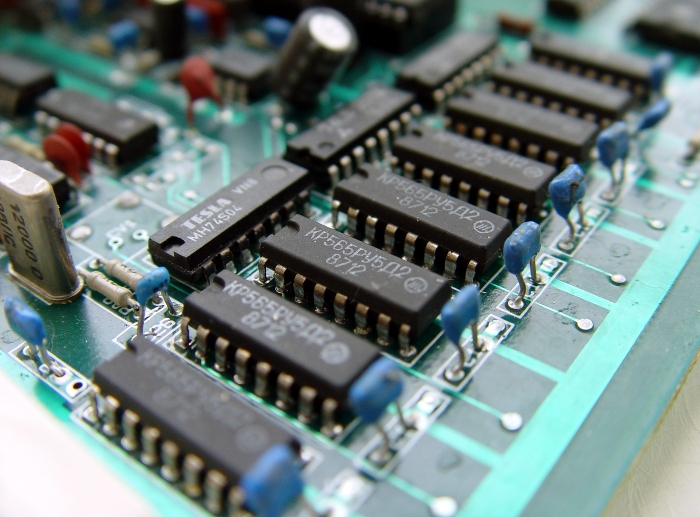
In general, this computer is really very interesting both as an Apple clone and as a simple very old, but legendary Soviet computer.
It will take a worthy place in our Museum of computer antiquities .

On the line of these computers was brought up the current generation of it-Schnick.
Meet the new exhibit of our computer history museum, Pravez 8D.

Today I want to tell you about the next very interesting exhibit of our museum of computer antiquities . It's about the Pravets 8D computer.

The line of these computers can be called legendary only for the fact that at one time he stood in every third school (Pravtsy 8A were supplied to educational institutions) of the entire Soviet Union, as well as the majority of the socialist countries of the world. Many of today's IT specialists began precisely with Pravtsev, it was he who became for many their "first computer in life."
')

The name "Pravets" comes from the name of a small village in Bulgaria, in which there is a plant called "MIROPROCESSORN SYSTEMS", which actually produced these computers. Computers were produced for the fact that in the socialist countries there would be at least something that could be opposed to the American Eplum, which in those years had already gained some popularity.
The first computer that went into the series was IMKO-1 (Individual MikroKompyutr, sometimes deciphered as: Ivan Marangozov Copier Original, in honor of the creator) and it was released in 1980. They tried to make it as similar in functionality as possible with the Apple II. Almost it turned out - the computer received a RAM (RAM) of 48 KB (with the possibility of expansion to 64 KB), a ROM (ROM) of 12 KB. Central processor 1 MHz (exactly the same as the Apple II). A streamer was used as a storage device, since no disk drives were made in Bulgaria yet.
Interestingly, this model was primarily price - $ 2600, while Japanese and American counterparts were much more expensive.
They produced IMKO-1 until 1982, until it was replaced by IMKO-2 or, as it was also called, Pravets-82. By the way, the success of IMKO-1 pushed the Bulgarians to expand the department for the production of radioelectronic components in the city of Pravets to a factory for the production of personal computers. After Pravts-82 was the Pravets 8M (IMKO-2M), which was already based on the 2 most popular at the time time processors Z80 and MOS 6502.
Computers series "Pravets 8" were fully compatible with Apple II, both software and hardware. On Pravtsy it was possible to use the programs of the original Apple II, as well as its expansion card, without any modifications. The ROM of the character generator and Monitor control programs was slightly modified to support Cyrillic (uppercase Cyrillic letters instead of lowercase Latin letters), as well as to display the name PRAVETS (IMKO, IMCO-2M) instead of APPLE II when turned on. In addition, the Pravets 8 produced its own expansion cards - to increase the RAM to 192 or 256 KB, as well as the U-LAN board, which allows you to connect computers to a local network. The operating systems used are Apple DOS , ProDOS , UCSD P-System , CP / M (with a CP / M card), the most commonly used programming languages are assembly language , Applesoft BASIC , UCSD Pascal , Logo .
In 1985, the plant management (not without instructions from Todor Zhivkov, the first secretary of the Communist Party of Bulgaria, who, by the way, is from the city of Pravets), decided to create a “home computer” Pravets 8D:

For this model, a smaller case with a built-in keyboard unit was specially manufactured. The monitor was not shipped with it - instead it was supposed to use an ordinary household TV. The ROM was also changed to support both Latin and Cyrillic.
Initially, a cassette recorder was used as an external memory (which was supposed to be for those who would have a television), later, in 1990, a disk drive controller and a DOS-8D disk operating system appeared. The approximate price was around $ 290.

The Pravets 8D looked like, at the time of production, it is quite “fashionable” if you compare it with similar computers of that time, such as Vesta IK-31 or Sail VI-201 .

Take at least the case - white matte plastic, with branded peripheral badges (they, by the way, are very, very similar to icons on Apple computers ):

The power supply is built in, everything is very neat and clear.

In general, the Bulgarians managed to achieve a very large “similarity” to the original - Apple II, with both the hull and the parameters:

Well, software, as I said, you could use the same thing:

Well, my favorite toy on the Pravce school was “Moon Patrol” (moon patrol), in which you had to jump over the pits and shoot from all that above and to the right:

... only the monitors we had were not color, but black and green.
The keyboard at Pravets is a little different from the modern ones. First of all, the layout - no you "fyfva." Cyrillic is relatively Latin based on the principle of correspondence of transcription:

This layout is often called “YAVERT”, and its correct name is “phonetic”.

This “chord” was not so convenient for typing on one keyboard of the world :)

Each key on these keyboards was a separate element sealed into the board, in contrast to modern keyboards, where there is a common plate under the keys:

The "space" a separate mount

The staple is needed in order to press it from any direction, and not only in the center:

The buttons are "worn" on the key. All keys, except for the space, are glued, apparently, that they would not fly off.
The Pravets 8D computer itself consists of 3 parts - a printed circuit board with a keyboard, a power supply unit and a motherboard (if we draw analogies with modern computers).

On the keyboard board, the name “PRAVETZ 8D” is proudly etched.
But what this analog Apple looks like inside:

On the left is the keyboard, on the upper right of the power supply, and the rest is the computer itself.
The keyboard was replaceable and joined here with this “almost train”:

The CM630P CPU, which is actually a complete clone of the MOS Technology 6502 processor, which was used in computers like Apple I, Apple II and Commodore PET, on the left, the AY-3-8912 programmable sound generator that could generate 3- voice polyphony (8 octaves + white noise):

This is what RAM looks like:

In general, this computer is really very interesting both as an Apple clone and as a simple very old, but legendary Soviet computer.
It will take a worthy place in our Museum of computer antiquities .

Source: https://habr.com/ru/post/73097/
All Articles